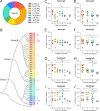Human genital antibody-mediated inhibition of Chlamydia trachomatis infection and evidence for ompA genotype-specific neutralization
- PMID: 34662351
- PMCID: PMC8523062
- DOI: 10.1371/journal.pone.0258759
Human genital antibody-mediated inhibition of Chlamydia trachomatis infection and evidence for ompA genotype-specific neutralization
Abstract
The endocervix, the primary site of Chlamydia trachomatis (Ct) infection in women, has a unique repertoire of locally synthesized IgG and secretory IgA (SIgA) with contributions from serum IgG. Here, we assessed the ability of genital and serum-derived IgG and IgA from women with a recent positive Ct test to neutralize Ct elementary bodies (EBs) and inhibit inclusion formation in vitro in human endocervical epithelial cells. We also determined if neutralization was influenced by the major outer membrane protein (MOMP) of the infecting strain, as indicated by ompA gene sequencing and genotyping. At equivalent low concentrations of Ct EB (D/UW-3/Cx + E/UW-5/Cx)-specific antibody, genital-derived IgG and IgA and serum IgA, but not serum IgG, significantly inhibited inclusion formation, with genital IgA being most effective, followed by genital IgG, then serum IgA. The well-characterized Ct genotype D strain, D/UW-3/Cx, was neutralized by serum-derived IgG from patients infected with genotype D strains, genital IgG from patients infected with genotype D or E strains, and by genital IgA from patients infected with genotype D, E, or F strains. Additionally, inhibition of D/UW-3/Cx infection by whole serum, rather than purified immunoglobulin, was associated with levels of serum EB-specific IgG rather than the genotype of infecting strain. In contrast, a Ct genotype Ia clinical isolate, Ia/LSU-56/Cx, was neutralized by whole serum in a genotype and genogroup-specific manner, and inhibition also correlated with EB-specific IgG concentrations in serum. Taken together, these data suggest that (i) genital IgA most effectively inhibits Ct infection in vitro, (ii) human antibody-mediated inhibition of Ct infection is significantly influenced by the ompA genotype of the infecting strain, (iii) the genital antibody repertoire develops or matures differently compared to systemic antibody, and (iv) ompA genotype-specificity of inhibition of infection by whole serum can be overcome by high concentrations of Ct-specific IgG.
Conflict of interest statement
The authors have declared that no competing interests exist.
Figures



References
-
- Rowley J, Vander Hoorn S, Korenromp E, Low N, Unemo M, Abu-Raddad LJ, et al.. Chlamydia, gonorrhoea, trichomoniasis and syphilis: global prevalence and incidence estimates, 2016. Bull World Health Organ. 2019;97(8):548–62P. Epub 2019/08/07. doi: 10.2471/BLT.18.228486 ; PubMed Central PMCID: PMC6653813. - DOI - PMC - PubMed
-
- Hoenderboom BM, van Benthem BHB, van Bergen J, Dukers-Muijrers N, Gotz HM, Hoebe C, et al.. Relation between Chlamydia trachomatis infection and pelvic inflammatory disease, ectopic pregnancy and tubal factor infertility in a Dutch cohort of women previously tested for chlamydia in a chlamydia screening trial. Sex Transm Infect. 2019;95(4):300–6. Epub 2019/01/05. doi: 10.1136/sextrans-2018-053778 ; PubMed Central PMCID: PMC6585279. - DOI - PMC - PubMed
Publication types
MeSH terms
Substances
Grants and funding
LinkOut - more resources
Full Text Sources
Medical
Molecular Biology Databases
Miscellaneous

